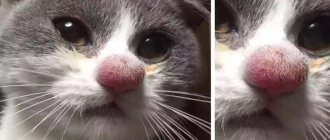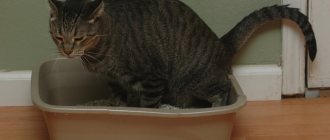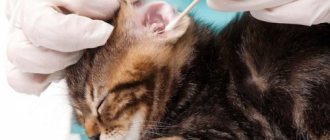If a cat's face is swollen, the reason for this may be a number of different factors, some of which are quite life-threatening for the pet. It is not always possible to notice a tumor in time, especially when the cat is long-haired. However, once the problem has been identified, it is important to visit a veterinary clinic as soon as possible to determine the cause of the lump.
What is edema?
Fluid retention in animal tissues occurs for various reasons.
There are two mechanisms for fluid accumulation:
- hydrostatic, associated with increased pressure in small vessels;
- hypoprotemic, associated with a violation of the protein content in the liquid part of the blood (plasma).
In the latter case, the permeability of small vessels increases due to inflammation, disorders of nervous regulation or toxic lesions.
The fluid that accumulates in the tissues can also be different:
- blood;
- lymph;
- pus.
Edema may vary in area and symmetry:
- they are limited (localized) and generalized (general);
- symmetrical and asymmetrical (for example, only one paw swells).
Limited swelling affects a small area of the body or organ. General ones cover large areas and indicate serious illnesses and a poor prognosis for the life of the animal.
Edema is caused by a condition called pre-edema. Predotec describes the state of preliminary accumulation of fluid in organs or tissues.
Rhinotracheitis, calcivirosis and other upper respiratory tract infections
Feline upper respiratory tract infection is a general term for respiratory infections caused by one or more viral or bacterial agents.
The infection may be caused by one or more viral and/or bacterial agents. The most common viruses that cause upper respiratory tract infections in cats are:
- Herpesvirus type 1 is also known as feline rhinotracheitis virus or FVR.
- Calcivirosis (FCV).
The most common bacteria that cause upper respiratory tract infections in cats are:
- Bordetella bronchiseptica.
- Chlamydophila felis.
Rhinotracheitis and calcivirus cause approximately 90% of all secondary respiratory tract infections in cats. Other, less common pathogens that can lead to purulent discharge and inflammation of the nose are:
- Mycoplasmosis.
- Rotavirus.
Causes of swelling
Swelling never occurs normally. The appearance of tissue swelling is always preceded by a pathological process.
Allergic edema
One of the most common causes of edema in cats is an allergic reaction. She might be local. But often an allergic reaction occurs in the form of angioedema. To the bite of poisonous insects, an allergy develops at the site of the bite. The animal's nose or paw swells greatly, the animal suffers from itching and pain at the site of the bite, and the temperature of the tissues at the site of the bite may be slightly elevated.
A typical reaction to flea excrement and parasite saliva is swelling of the animal's lips and even the entire muzzle. This is justified by the fact that insect waste products fall on the cat’s mucous membranes when licking. The same swelling can be a sign of a reaction to chemicals and even foods. In this case, apart from the swelling itself, there are no signs of inflammation. The skin is of normal color, not painful.
Traumatic edema
Edema of traumatic origin occurs at the site of injury (bruise or fracture), edema develops at the site of a bite by another animal or puncture of tissue with a sharp object.
In the first case, it is caused by tissue destruction at the site of injury.
In the second, the entry of a foreign body contaminated with pathogens or bacteria on the animal’s fang and rotting processes in damaged tissues.
If such swelling occurs when a fang bites the lip, the animal cannot chew; any movements of the jaws cause pain to it. With post-traumatic edema, the animal avoids touching the site of injury. The skin at the site of injury is hyperemic, and the local temperature is elevated.
Edema associated with internal organ disease
Partial swelling affecting only the pet's hind legs is a sign of a serious pathology (heart disease or kidney failure). In this situation, most often both limbs swell (the swelling is symmetrical). In renal failure, swelling begins at the animal's fingertips and gradually rises upward. The swelling is not painful, the skin does not feel hot, the animal may not even notice it, moving as usual.
Swelling caused by joint disease
This swelling is often asymmetrical. It occurs in the joint area, accompanied by pain and hyperemia, stiffness when moving. The cat limps while moving, and sometimes it is very painful for her to step on her paw.
Edema due to venous insufficiency
Vascular pathologies do not escape even four-legged pets. Cats can have venous congestion, leading to edema. The cause of swelling may be a blood clot. It mechanically blocks the movement of blood through the vessel. This swelling is asymmetrical and is accompanied by unpleasant sensations in the affected limb. Thrombosis and thrombophlebitis, increased permeability of the vascular wall are a common cause of edema.
Tumors as a cause of edema
With tumors of the mammary glands, the animal's paw on the affected side may swell. Such swelling can be quite noticeable. The skin is usually not hyperemic. Edema develops due to mechanical compression of the lymphatic ducts by tumor growth.
Causes and accompanying symptoms
Traumatic injuries
A cat that roams freely on the street is not protected from fights. A pet can receive various injuries, but often it is the face that suffers. You can often notice that a cat’s nose is swollen, the bridge of its nose and ears are torn, and its lips are bleeding. A broken jaw is also possible, causing the entire face to swell. When there is an open wound, it can become infected, which can lead to serious complications for the entire body.
If your pet gets into a fight, it is important to provide first aid and disinfect the wounds as soon as possible.
Neoplasms
When a pet develops a tumor on its face, it looks like a lump. Often, compression of the lymphatic vessels occurs, which causes stagnation of lymph, leading to swelling. A lump that has formed on one side of the muzzle can be not only benign, but also malignant. In such a situation, pets will require urgent surgical intervention, since cancer can cause death. In addition to swelling of the muzzle, the appearance of neoplasms provokes the following symptoms:
The appearance of neoplasms, both malignant and benign, is accompanied by diarrhea and constant vomiting.
- diarrhea;
- constant vomiting;
- bleeding of unknown nature;
- non-healing wounds.
Abscess in cats
It is the appearance of cavities in the tissues, inside of which there is pus. Often a pathological condition occurs due to infection. When the face swells, the first thing the owner needs to do is to examine the oral cavity, since cats often suffer from gumboil. It is important to remember that only a veterinarian should open an abscess. When an abscess occurs, you may notice the following symptoms:
- the area that is swollen is hot to the touch;
- when touching the tumor, the cat experiences pain and meows heavily;
- the hair on the cone falls out;
- blood and pus are released from the wound;
- general body temperature increases;
- the cat becomes apathetic.
Bites and swelling
Cats are most susceptible to bee and wasp stings. Despite the caution of pets, sometimes they can interact with these dangerous insects for fun. Often, the owner may notice that the cat's nose is swollen. The eyelids and lips also suffer. In addition to the appearance of swelling, your pet's body temperature may increase. A playful and hunting character can make a cat fight with snakes. Since the venom of these reptiles is toxic, it causes severe allergies, which manifests itself in swelling of the muzzle.
Acne in cats
In most cases, cat acne is located on the chin and, in its advanced form, causes severe swelling.
This pathology occurs not only in humans, but also in animals that also have sebaceous glands. The largest number of them are localized on the chin. Initially, the development of acne is accompanied by the appearance of blackheads. When the owner overlooked this symptom and appropriate therapy was not carried out, folliculitis occurs. This pathology is characterized by the appearance of voids with pus in the follicles. At the same time, the cat's muzzle becomes very swollen, the pet becomes less active, and its temperature rises.
Allergic reactions
Allergies in pets can be caused by chemicals, products, individual components of medications or complementary foods, pollen, hygiene products, and litter for the tray. In addition to the swelling of the muzzle, the following symptoms are also observed:
- the appearance of redness, rashes and peeling on the skin;
- itchy skin;
- sneezing;
- vomit;
- dyspnea;
- increase in body temperature.
Lymphadenitis
If your pet behaves apathetically, you should palpate the lymph nodes, as their enlargement indicates an inflammatory process.
It is an inflammation of the lymph nodes, which is not considered a separate disease, but serves as a sign that inflammatory processes are occurring inside the body. This pathological condition can be suspected if the owner closely monitors the condition of the pet. The lymph nodes that have been affected become hot to the touch. The cat becomes apathetic, spends most of its time in a lying position, loses its appetite, and at the same time absorbs copious amounts of water.
Prevention
Walking your cat on a leash will help you avoid unnecessary injuries or fights with other animals.
To reduce the likelihood of facial swelling in cats, veterinarians recommend that owners carefully monitor their pets. It is better not to let them go outside alone, which will protect the animals from fights, injuries and bites. Walking without an owner is most dangerous for cats that are over 3 months old. Their fear has already disappeared, but the kittens have not yet fully grown up to adequately assess the threats and fight back the offender. It is important for cat owners to remember that industrial complementary foods sold in stores can cause allergic reactions. If a decision has been made to diversify your pet’s diet with a new food, it is recommended to introduce it gradually, observing the response of the animal’s body. An important preventive measure is a systematic examination of the cat, its ears, eyes, nose and mouth. You should attend routine medical examinations with your pet at a veterinary clinic, which will help identify the development of pathologies at the initial stages.
Insect bites as a reason why the face of cats becomes swollen
Insect bites - ticks, fleas or bee stings - are the most likely causes of facial swelling, itching and pain in cats.
Among insects, the danger to small domestic animals is mainly represented by representatives of the Hymenoptera family (bees, wasps).
The venom of these insects contains vasoactive substances that cause allergic and toxic reactions in animals.
Most bites are usually located on the head and limbs. Symptoms can range from mild swelling to a systemic anaphylactic reaction and multiple organ failure in the case of multiple bites. In the case of single bites, the disease process is usually limited to local swelling, redness and tenderness at the site of the bite. Treatment involves removing the sting and treating the bite site with a baking soda solution. To avoid an allergic reaction, the animal can be given several tablets of Suprastin or Claritin. A sting in the mouth is especially dangerous - when an unreasonable animal “catches” a bee - due to the possibility of swelling of the respiratory tract. In this case, it is better to immediately administer an anti-inflammatory and antiallergic drug (dexamethasone), preferably to the site of swelling. If an animal is hypersensitive to Hymenoptera venom, a local or general allergic reaction may occur with swelling and swelling of the muzzle, eyelids and earlobes.
A generalized allergic reaction can manifest itself in the form of urticaria (vesicular rash) and anaphylaxis with a sharp drop in blood pressure and collapse.
A generalized toxic reaction is a general poisoning of the body by toxic products that enter the body in critical quantities. Symptoms include fever, depression, weakness and a drop in blood pressure (shock), including death.
Treatment of allergic reactions includes antihistamines (suprastin, claritin, cetrin) and glucocorticoids (dexamethasone) in combination with decongestants (furosemide) and intravenous calcium gluconate. Treatment of toxic reactions should be carried out on an outpatient basis using intravenous drip infusions, oxygen inhalation and glucocorticoids. Skin repellents - spots (Bars, Frontline) have some preventive effect against repeated bites of blood-sucking insects.
Lymphadenitis
When the lymph nodes (submandibular, axillary) are inflamed, the inflamed tissues swell greatly, the area of edema is very painful on palpation. When the submandibular lymph nodes are inflamed, the animal cannot chew (the process is very painful).
Swelling after sterilization
Postoperative swelling is not uncommon. Swelling and redness may be observed in the scar area. This occurs due to swelling of the internal sutures. No treatment is required; after the internal sutures are absorbed, this swelling goes away on its own.
Routes of infection
The causative agents of rhinotracheitis and calcivirosis are widespread. The carrier spreads the virus throughout the environment through saliva, nasal discharge, feces and urine. Vaccinated cats become infected through contact with carriers. Animals that have not received vaccination are at risk of getting sick from contact with soil, water and environmental objects.
In most cases, cats become infected through direct contact with a carrier, as viruses and bacteria can survive in the environment for up to 18–24 hours. The danger of rhinotracheitis and calcivirosis is that a visually healthy (recovered) animal can remain a carrier for a long time.
Oral cancer as a reason for swollen faces in cats
Oral cancer accounts for 3% of all cancers in cats. Cats aged 11-12 years are most often affected, but cases of the disease have also been reported in younger cats. The most common types of oral cancer in cats are squamous cell carcinoma (70%) and fibrosarcoma (20%); much less common are lymphoma, malignant melanoma, osteosarcoma, chondrosarcoma, fibrosarcoma, hemangiosarcoma and ameloblastoma.
Squamous cell carcinoma of the tongue often spreads to surrounding tissue and bone. The main symptoms are swelling of the mouth, difficulty breathing, problems with chewing and swallowing, and excessive discharge from the mouth (drooling). Squamous cell carcinoma has a dangerous rate of spread/invasion into surrounding tissue, so early diagnosis offers the best prospects for treatment. Treatment depends on the location of the cancer; surgical removal of the tumor followed by chemotherapy and radiotherapy may be recommended. Tumors of the oral cavity in cats rarely (in less than 10% of cases) give hematogenous metastases to the lungs, with a tendency to locally destructive growth, recurrence and metastasis to regional lymph nodes. Life expectancy for oral cancer depends on the histological type and location of the tumor, as well as the stage of tumor development.
Factors that cause oral cancer in cats include the use of canned food in the cat's diet and smoking by the owner. For example, cats whose diet consists of more than 50% canned food have an increased risk of developing squamous cell carcinoma and thyroid adenocarcinoma. Nicotine metabolites were found in higher concentrations in the urine of cats whose owners smoked than in the urine of passive smokers. The fact is that the surface area of an animal's fur is many times greater than the surface area of its body, which contributes to the accumulation of tobacco smoke in the fur in a much higher concentration than if the animal were without hair. The concentration of nicotine metabolites in the urine of domestic cats whose owners smoke more than 20 cigarettes per day is comparable to the concentration in a human smoker.
Treatment
First aid depends on the cause of the swelling. If the swelling is caused by a blow or bruise, cold can be applied to the site of the bruise in the first day after the injury. The next day, the injury site needs to be warmed up.
If the swelling is cold, it is sometimes recommended to knead the animal’s limb to restore blood circulation. If blood flow is disrupted, this can bring relief to the pet, but in the case of thrombosis, massage can cause a blood clot to break off and embolism.
In case of “hot” swelling, it is recommended to apply cold compresses. This is acceptable for insect bites. But in the case of inflammatory processes, specific treatment with antibacterial agents is necessary.
If there is swelling, it is worth taking your pet to the veterinarian to find out the cause of the phenomenon and prescribe proper treatment.
Snake bite
Cats also often become victims of snake bites. Of course, this is not typical for pets living in an apartment and not going outside. But for cats who live in the house or come to the country in the warm season - it’s fine.
Of course, the greatest danger comes from the bites of poisonous reptiles. This may well lead to shock and even death of the animal. However, even the bite of non-venomous snakes poses a certain threat. Primarily due to the fact that during a bite a wound is formed, into which infection from the snake’s teeth enters. Because of this, a focus of inflammation arises, which can lead to dire consequences.
To prevent this from happening, you need to use antibiotics. But there is no particular rush here - it is enough to take action in the next few hours.
But if you are bitten by a poisonous snake, you need to act as quickly as possible. Alas, not every home medicine cabinet has an antidote, so it is advisable to immediately visit a veterinarian. Along with the antidote, he may give an injection of diphenhydramine. After the shock has been relieved and the effects of the poison have been eliminated, the doctor may also prescribe broad-spectrum antibiotics to eliminate the possibility of inflammation.
What can cause a cat's face to become swollen?
Cats are very patient: not every disease can be noticed by the owner immediately. In cases of swelling, the matter is complicated by the presence of hair, sometimes extremely long and thick. It happens that the disease goes far and the animal goes to the veterinarian when it becomes completely lethargic and loses its appetite.
For some time, the owner may not notice that the cat’s face is swollen, although here the coat is much shorter and sparser. Swelling or edema is only a symptom and accompanies many painful conditions. Therefore, your pet needs to be shown to a veterinarian as soon as possible.
Dental diseases
A swollen face in a pet can be caused by dental problems. If the cat's face is swollen, and an allergy is definitely excluded, it is necessary to carefully examine the oral cavity. Broken teeth can irritate the tissue around them, potentially causing swelling. Swelling of the gums, in turn, leads to pronounced swelling of the lower or upper jaw, depending on the location of the broken tooth.
Another reason is gumboil or purulent abscess of the gums. This pathology is manifested by a bacterial infection that has entered the soft tissue of the mucosa. As a result, an abscess forms in the affected area - a large cavity filled with pus. A large abscess is visible to the naked eye, as one side of the cat’s face swells.
The disease is dangerous because the infection spreads throughout the body through the bloodstream. It can only be treated surgically. The operation consists of removing the damaged tooth and cleaning the cavity from purulent exudate. After opening the abscess, treatment continues with antibacterial agents at home.
Allergic reactions
If a cat's face is swollen after changing its usual diet, the reason lies in an allergic reaction. Food allergies in pets occur primarily when feeding dry or canned food. Changing food from the usual manufacturer, introducing vitamin supplements into the diet, or simultaneously feeding natural and dry food - all this is fraught with the development of allergies.
Food allergies in cats often manifest as swelling on the face, mainly in the area around the mouth. This is accompanied by itching, so the cat may scratch the affected area until there are large wounds. In addition to the muzzle, swelling of the ears, redness of the ears, and discharge from the eyes and nose are noted.
To treat allergies in animals, the irritant must be identified. If symptoms appear after changing the diet, the pet should be transferred either to its usual diet or to a hypoallergenic diet. As a rule, swelling subsides within 1-2 days after the irritant is eliminated.
The same reaction may occur in response to certain medications, in particular flea drops, household chemicals, or animal bathing shampoos. Allergy symptoms appear quickly, within a maximum of two hours. Having noticed alarming signs, the owner should analyze recent events and identify a potential irritant. If it is household chemicals or “cat” shampoo, the fur should be thoroughly rinsed with water to eliminate the smallest particles of the allergen that may remain on the skin.
Rinsing the nasal passages
If a pet cannot breathe normally, this may be due either to the fact that its nose is clogged with dried exudate, or due to swelling and swelling of the mucous membranes. In all these cases, we recommend rinsing the animal’s nose, as this contributes to its speedy recovery. The procedure is not without pitfalls, and therefore we recommend enlisting someone’s help. Rinsing a cat's nose is done as follows:
- The solutions used for washing must be heated to a temperature of approximately 37°C.
- Ideally, you should use the smallest syringe for flushing, but an insulin syringe works well for this purpose. We recommend connecting a tube from a catheter for intravenous injections to its spout. It is thin enough to be inserted into the animal's nostrils.
- After this, the pet must be carefully secured in a lying position. If for some reason you were unable to get an assistant, you can press the cat’s head between your knees.
- When the cat is securely secured, they begin to inject the rinsing solution first into one nostril, then into the other. You can fill no more than 0.5 ml at a time. After each serving, it is necessary to pause so that the pet has time to rest properly.
- At the end of the procedure, it is necessary, using a gauze pad soaked in warm saline, to clean the cat’s face from any remaining washing liquid and exudate.
Since the animal will probably not be in the best mood after rinsing the nose, medicinal drops or other medications must be instilled/applied immediately, without letting the pet go! Otherwise, there is no guarantee that he will be caught.
Solutions used for rinsing the nasal cavity
In most cases, ordinary saline solution can be used for rinsing. But it is still better to treat the nasal cavity with a 0.05% chlorhexidine solution. It is not much more expensive than saline solution, but it has anti-inflammatory and antibacterial effects.
You may be interested in: Redness and swelling with lymphostasis
In addition, when treating rhinitis and, accordingly, nasal congestion, there is often a need to relieve swelling of the mucous membranes (as discussed above). For this purpose, you can use a 1-1.5% solution of ordinary table salt.
But! In order for rinsing to be effective and really help restore the cat’s former ease of breathing, it should be done regularly and as often as possible. So, for purulent rhinitis, it is recommended to rinse the animal’s nose every one and a half to two hours, until the symptoms completely disappear. If you carry out the procedure a couple of times a day, there will be no effect from it!
What to do if your cat's face is swollen?
The article describes the topic: “What to do if a cat’s face is swollen?” with comments from professionals and a list of interesting literature on the topic.
This article provides general information that describes typical situations that veterinarians have to deal with in practice, and also provides explanations for such problems.
The cat's gums and cheek are swollen, what could it be and what to do?
The main reason why the cheek and gums may swell is tartar, accumulation of food debris or hair. All this leads to the development of the inflammatory process. Treatment involves daily treatment of the oral cavity, as well as gum massage. If necessary, the doctor may prescribe antibiotics.
A cat has a swollen cheek and a swollen eye, how to remove a tumor under the eye
Try dropping hydrogen peroxide into your eye, or soak a swab in it and gently blot your eye. Tetracycline ointment can be placed under the eyelid. If the animal behaves calmly, try applying something cold, this way the swelling and inflammation will be relieved.
How to help a cat's cheek is swollen after a fight
If abrasions or wounds are visible, they should be treated with hydrogen peroxide and also smeared with Levomekol ointment. In addition, it could be an abscess; in this case, only a doctor can help.
The cat's upper or lower lip is swollen: causes and how to treat
There can be many reasons why cats' lips swell - new food, a bite, injury, the development of an allergic reaction, some kind of viral infection. It is simply unreasonable to recommend any action in this case. Treatment primarily depends on what exactly became the provoking factor, so for the sake of your pet’s health you need to visit the hospital.
The cat's upper eyelid is swollen
There are several diseases that can cause the upper eyelid to swell. Blepharitis - development is provoked by infections, as well as mechanical injuries. Development of allergies - in this case, accompanying symptoms may be present, for example, a runny nose. Injury – a foreign object entering the eye can lead to swelling. Damage from bacteria or infections.
The cat's back paw is swollen and he is limping, what should I do?
If you notice such a problem, you need to carefully examine the paw: are there any foreign objects, integrity. Gently feel and see if the cat is in pain. Take something cold and apply it to the paw; the limb must be immobilized. The next necessary step is to see a doctor.
The cat's paw is swollen
One side of the cat's face is swollen
The muzzle on one side may swell for the following reasons: - Phlegmoma is a purulent inflammation. — Development of an allergic reaction. - Poisoning. - Some kind of hematoma. — Myositis is a condition in which muscle inflammation occurs.
The cat's mammary gland is swollen while feeding a kitten
The mammary gland may become swollen due to the development of a disease such as mastitis. The thing is that pathogenic microorganisms begin to settle there. You can take some measures yourself only at the first stage of the development of the disease. You can express milk manually, but it is unlikely that your cat will allow you to do this. You cannot massage or use anything to warm you.
The cat's front teeth are swollen
Gingivitis is a disease in which the gums become inflamed and swollen. At the first stage of development it may be asymptomatic. The cause of the tumor can also be mechanical damage. The first thing you need to do is brush your teeth. The oral cavity should be treated with decoctions based on medicinal herbs - chamomile, oak bark.
The cat's ear is swollen
The cause of the tumor may be external otitis media. The disease is of two types - acute and chronic. Try treating your ear with silver nitrate. Iodoform ether can be instilled into the ears themselves.
The cat's paw is swollen after a catheter
In order to remove the swelling after the catheter, it is necessary to lubricate the paw with heparin ointment and be sure to ensure that the cat does not lick it off.
The bridge of the cat's nose is swollen, what should I do?
The cause of the tumor may be bone injury or an allergic reaction. First of all, apply something cold, this can relieve pain and reduce swelling. The next action should be to go to the clinic.
A tumor is an abnormal growth of cells in the body. Tumors come in two types: benign and malignant. It is a malignant tumor in a cat that may indicate the development of cancer.
A tumor in a cat is a fairly common occurrence. The risk of their development increases with the age of the animal. Thus, the cause of death for many domestic cats over 10 years of age is cancer. It is very important that owners identify the development of the disease in an animal in a timely manner, because in this case the chances of successful treatment and prolongation of life increase.
To determine the type of neoplasm in a cat, a veterinarian will take a tissue and lymph node biopsy, blood analysis, and do an X-ray and ultrasound. Unfortunately, cancer does not manifest itself in the early stages, so only constant monitoring of the animal’s condition and detection of tumors can help determine the disease.
A tumor in a cat may indicate the development of various types of cancer. The rarest thing to encounter is animal skin cancer. To detect skin cancer, you should monitor your cat's skin pigmentation. This disease is very difficult to determine, because it is almost impossible to detect abnormal pigmentation under the fur.
Breast cancer is the most common tumor and accounts for 85% of all cancer cases. To identify it, you should periodically examine the area of the cat's mammary glands. If you detect the slightest neoplasm, immediately consult a veterinarian. A malignant tumor in a cat will begin to grow and develop very quickly, so the sooner treatment is carried out, the fewer consequences the animal will have.
Tumors in the nasal and oral cavities are also very common. Their presence and progression may be indicated by foul breath, bleeding, difficulty breathing or swallowing.
Bone cancer is very rare, but it is quite pronounced. Its development may be indicated by difficulty moving, lameness, and inflexibility of the body.
If you discover a tumor in a cat and, when you go to the doctor, the animal is diagnosed with cancer, do not rush to panic. The treatment plan for your cat will depend on the stage of the disease and the general condition of the animal. There are two treatment methods: surgical and conservative.
Carrying out a surgical method is not always advisable, because if a cat’s tumor is too large, there is no point in removing it, since the animal may simply not tolerate the operation. The conservative method is the treatment of cancer using immunotherapy or chemotherapy. Immunotherapy is carried out in combination with other drugs that increase the body's resistance to the disease. In some cases, the use of immunotherapy leads to a complete recovery of the animal, in others it only slows down the development of the disease.
There are no specific feline medications to treat cancer in cats, so medications designed for humans are often used. Thus, the use of ASD and ASD-2 gives positive results, but again, you should not intensively treat your cat at home.
You should also remember that the choice of the clinic where you will treat your cat should be taken seriously. After all, many veterinarians do not treat the animal, but heal it until death, perform surgical interventions where they are not needed, or when it is too late to carry them out. It is best to consult several clinics and choose the optimal type of treatment. If you cannot do without surgery, be prepared for the appearance of metastases in the animal.
Metastases are daughter tumors from the mother tumor after its removal. Metastases are dangerous because they appear unexpectedly and in the most unimaginable places: they can appear in the lungs, stomach, liver or brain. But before they appear, the animal will have a couple more years of a carefree and joyful life.
If you see that no treatment methods can help the animal, you can leave the disease to chance. There are cases when, after the onset of a crisis, an animal experiences an improvement in its well-being, because the body begins to activate internal forces to fight the tumor.
source
Fighting baldness in cats
Cat owners, having noticed changes in the animal’s hair, begin to panic and look for an answer to the question of what to do if the cat’s hair falls out. Different causes of hair loss require different treatment approaches.
The longest and most difficult treatment is when hair falls out from skin mites and fungal diseases, which require the use of toxic drugs strictly according to the regimen prescribed by the doctor. At the same time, a thorough disinfection of the room will be required, including treatment of all carpeting and furniture, as well as disinfection or replacement of the cat’s bedding.
The result of an unbalanced diet, accompanied by signs of partial baldness, for example, when a cat has flaking hair on its hind legs, is treated mainly with diet. Pets on dry food should receive enriched vitamin complexes, and those on a natural diet should receive low-fat foods with the addition of B vitamins. To relieve itching, antihistamines can be given in small doses no more than twice a day.
Feline acne as a reason why the face of cats becomes swollen
Feline acne is the most common problem in cats and involves swelling of the chin and face. It manifests itself as inflammation of the sebaceous glands, during the development of which pustules form in the corners of the cat’s mouth and chin.
A cat's skin has two types of glands: sweat glands and sebaceous glands.
The sebaceous glands are directly connected to the hair follicles and serve to secrete sebum, which is used to maintain waterproof hair and elasticity of the skin.
It is on the chin, lips, eyelids, foreskin and scrotum that colonies of larger sebaceous glands are located.
Hair follicles produce excessive amounts of oily secretions (sebum) and probably too much keratin (the main protein of skin and hair). This leads to clogged oil glands and the formation of blackheads called blackheads that cover the skin around the hair follicles. Secondary bacterial infection can lead to inflammation of the hair follicles (folliculitis) and the formation of pus-filled papules and pustules. In severe cases, the infection affects a large area of skin and pyoderma develops with severe swelling, inflammation and pus leaking from the affected hair follicles. Treatment for cases of feline acne involves removing excess sebum, which prevents the formation of blackheads and secondary infections.
In mild cases, disinfecting the affected areas 2-3 times a day with antibacterial soap or iodine solution (weak tea color) will be quite effective and no further treatment will be required.
For more severe cases, an ointment or gel containing benzoyl peroxide (such as OxyDex) or chlorhexidine is used.
However, in case of secondary infections (fungal infections) with the formation of acne and swelling, additional antibiotic therapy is necessary.
The exact cause of Katkin acne is not known, but the prerequisites for the development of this disease are primarily hormonal disorders, poor care and maintenance, monotonous unbalanced diet and the use of plastic utensils.











